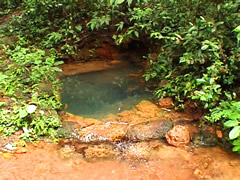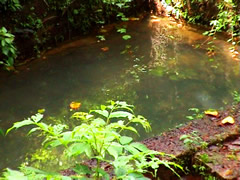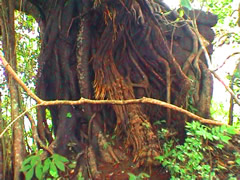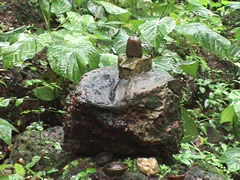Seven Sacred Springs:
Explorations around Assagao
By Chinmaya Dunster

The only other specific reference in the book was to a spring called Dossazor at Dossoxir, and a grainy picture of a rectangular walled pit accompanied it; but, once again, the book gave no indication as to its location. A local friend had vaguely heard of it and pointed me north over the hills to Sonarkhed, a small corner of Assagao parish which lies outside the main valley. There I took a path past the last houses and the Sri Dutta Hindu temple into old coconut and mango plantations. Pre-monsoon clearing of unwanted underbrush had obviously taken place and the little valley was choked with cut branches. Noting again the ruined walls and abandoned channels, I began to understand that this, like the Valle and the Vau beside my house, were part of some huge irrigation system that had once fed the village with water for agriculture.
 Sonakhed Spring
Sonakhed SpringPhoto: Chinmaya Dunster
The spring itself in the pre-monsoon heat was a mere trickle emerging beneath a dark ochre rockface and fed a pool just big enough for a shallow but welcome dip. It was my second one of the seven, but clearly not the Dossazor in the photo.
Next, a bit of luck on a Google search led me to a map. Finally, a proper, large-scale map, albeit not one with a single name on it! The Assagao Regional Plan is the product of the village Panchayat (the lowest tier of local government), and apart from marking with symbols the sites of five churches and six temples, it concerns itself solely with plot numbers and zoning regulations. But there, on the southern boundary of the village, was an arrow marked "SPRING."
I must have driven past it dozens of times over the years, for it sits right beside a popular shortcut through to the tourist belt at Baga. And sure enough, a battered, handpainted sign on the road I had never before bothered to read said: Do not throw garbage in the vicinity....Notice issued by vilagers of Dasashir.
 Dossazor Spring
Dossazor SpringPhoto: Chinmaya Dunster
I found the Dossazor spring beneath a mighty banyan, which blocks any view of it from the road. It is approached through a little ramshackle temple and has, as the photo showed, been neatly walled with the local laterite into a rectangular pool. In this season, when any water is a blessed relief from 38 degree heat and 95% humidity, the coolness of the spring’s water on my hand was almost a shock. Even though it was deserted, it felt just a little too public a place for me to strip off for a dip, so I contented myself with paddling my feet in the orange-tinted water and abandoning myself to the sensation of schools of tiny fish nibbling at my toes.
Here I must interrupt the narrative flow to illustrate my point about the survival of ancient pre-Christian beliefs during the centuries of Portugese rule. For, on one of my rambles a year or so ago, I had stumbled into an extraordinary spot hidden amidst overgrown cashew trees commanding the steep hillside above the place which I had now established was the Dossazor: a rare surviving devrai or sacred grove. I have visited some of these ancient forest patches in the neighbouring state of Maharashtra, which retained its Hindu identity under British rule. They are considered sacred to a powerful local nature spirit and it is forbidden to cut or remove anything from within their boundaries at the risk of the spirit’s wrath. They thus contain remnants of original pre-human occupation vegetation, often with rare and medicinal plants that are extinct anywhere else in the area.
 sacred tree in devrai
sacred tree in devrai ritual objects in devrai
ritual objects in devraiPhotos: Chinmaya Dunster
This devrai was focused around a twisted banyan entwined with creepers, some of them thicker than a thigh, which take centuries to mature to such a size. It must have been planted once, for its maze of roots begins at chest height, clutching a support of shaped laterite blocks. Scattered on the forest floor I found terracotta waterpots, tiny mirrors and little green combs, many of them already entombed in mud and leaf litter. Apart from these ritual objects, there was no sign of more recent "Hinduization": no religious images or symbols, no coloured threads tied around the tree trunk as is usual at venerated trees in temples and villages throughout Hindu India. Yet despite the absence of a god or goddess to worship, someone was still coming here to pay their mysterious respects, as his or her ancestors must have been doing during the long Christian centuries when other such places had been uprooted. My mind reeled back even further to a time when this hillside was part of unbroken primaeval forest, inhabited only by peoples whose remnants India now calls tribals, and who had recognized this spot above the spring, and perhaps even the ancestor of this tree, as special.
Once again Google Earth came to my rescue in uncovering a fourth sacred spring. I was learning to judge the varied shades of green on satellite photos and, while the Valle was clearly in the largest area of the darkest shade (indicating mature forest), right opposite my house on the hillside above Bairo Alto ward was a smaller patch of the same colour. I took myself up there just as the cashew harvesters were hacking a path through last monsoon’s overgrowth up to the orchards. Their track passed a gully full of impenetrable jungle and forked at a tall banyan. The harvesters headed their way up the upper one and I took the lower down to the streambed. This was dry, and already redolant with the scent of fallen and fermenting cashew fruits, but upstream a tiny cave beckoned.
 Sivalingam and yoni at Bairo Alto spring
Sivalingam and yoni at Bairo Alto springPhoto: Chinmaya Dunster
Sure enough, even in May, the driest month of the year, when not a drop of rain had fallen for seven months, a shrivelled pool lay hidden within it. Not inviting for a drink, or even a wash, but it was a spring and I knew that with the monsoon the place would come fully alive again. A little yoni (vagina-shaped stone) with a loose river-polished pebble lingam (phallus) had been cemented onto a rock beside the spring. This is a recent addition for sure, and like the little temple under the banyan at Dossazor, a sign that the Hindus of Assagao had been reclaiming their heritage.
Did you like the article? Subscribe here to our New Article Email Alert or RSS feeds.
Sharing is caring! Don't forget to share the love, and keep the conversation going by leaving a comment below:
Advertisement
